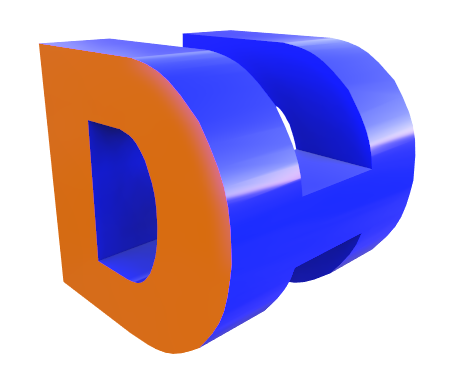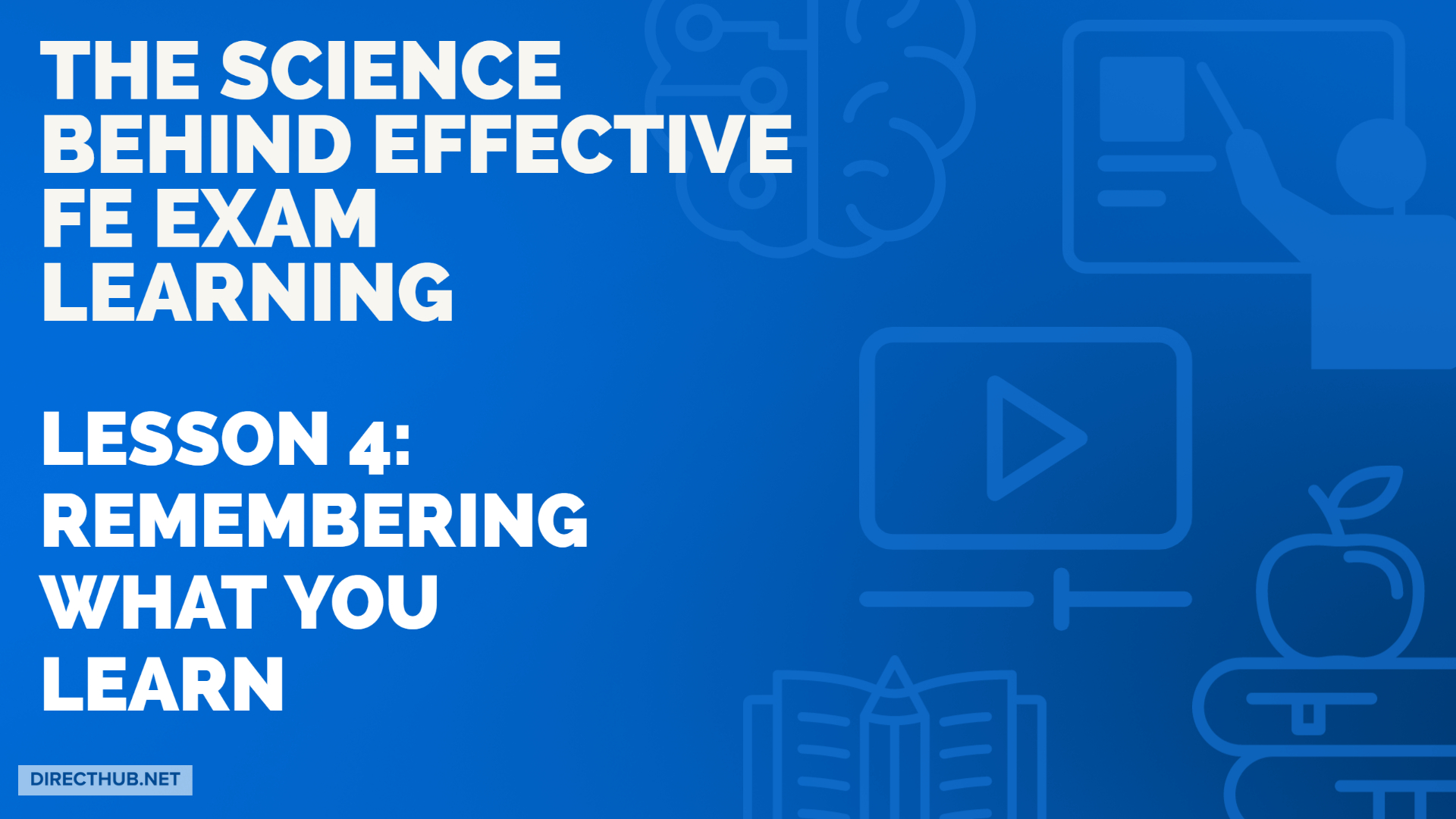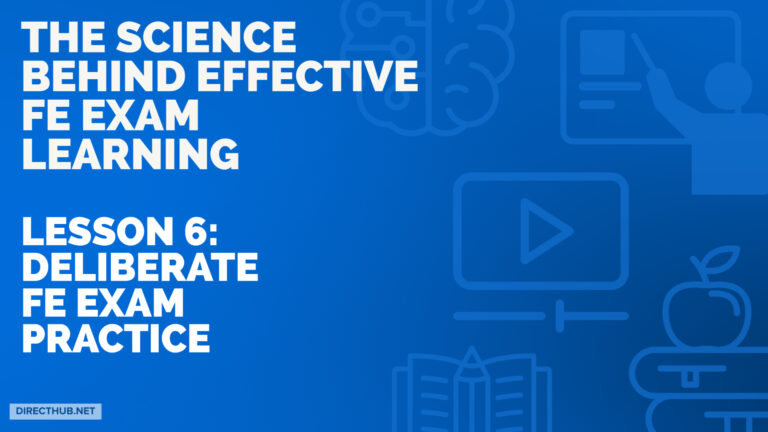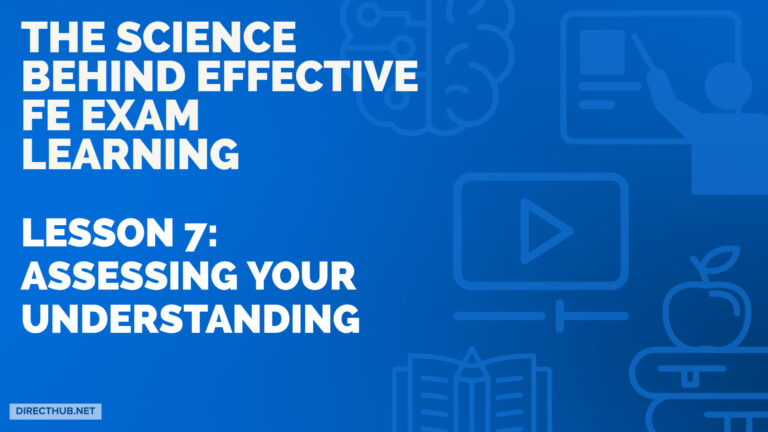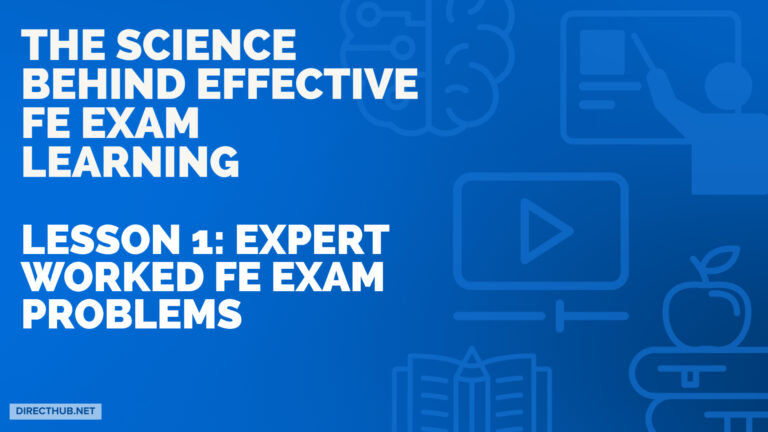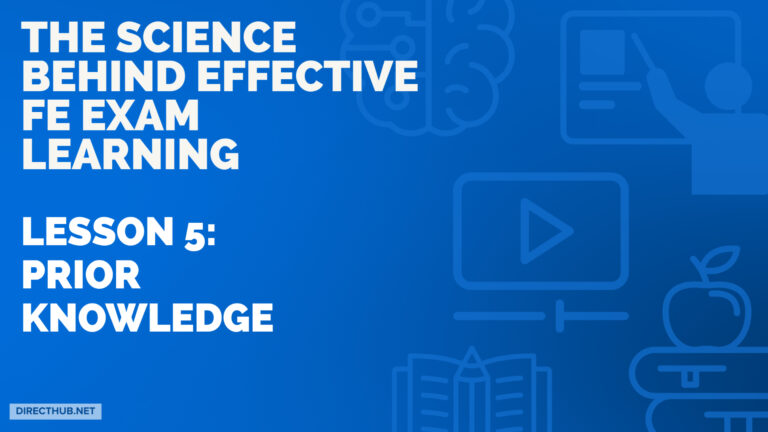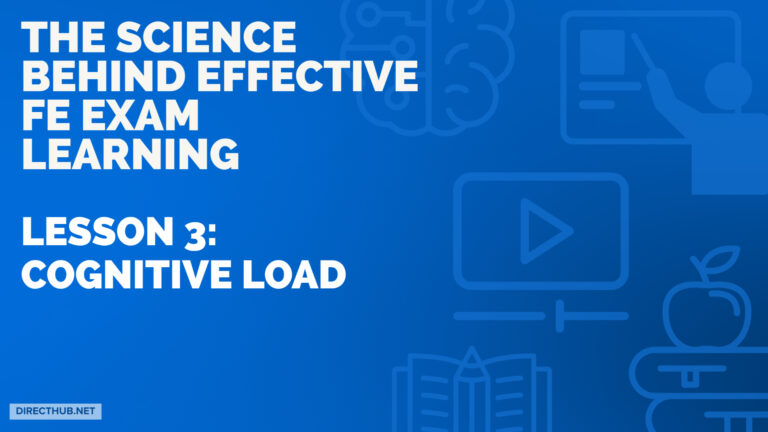Lesson 4: Stop Forgetting what you Learn for the FE exam
Last lesson, we discussed how cognitive load can impair our memory when studying for the FE exam. If you missed this, you can find it here.
Learning skills and concepts for the FE exam requires remembering some information, but many students use ineffective techniques to remember.
Most of the time, students will re-read, write word for word, or highlight material as a way of remembering the material. These techniques are ok but they’re not that effective.
The techniques we will discuss today – “Generation” and “Elaboration”- are much more effective.
Memories are like a giant network of associations. When you hear “meow” you are likely to associate that sound with a cat. Hearing a person’s name or remembering the place where you both met will make it easier for you to remember their face. These two learning mechanisms exploit this idea of Generation and Elaboration.
Generation – Active Recall
We will use the word “generation” interchangeably with “active recall”. Generation is about making the links between memories stronger. When we try to remember something, our brain strengthens the link to what we’re trying to remember.
So, what study techniques use generation?
1) Practice Tests
Practice tests or quizzes use generation or active recall. When you try to attempt to answer a question or solve a problem before being shown the solution, you are making the initial effort in recalling information from your brain to apply the right steps/process to arrive at the final answer.
You may be asking this. How will I know what information needs to be recalled for a certain practice problem? If you’re starting from scratch, doing active recall will not help much. You will need to first cover important concepts, make study notes, create equation sheets, slowly solve practice problems – before you can exercise your powers of active recall.
Let’s look at one method you can use the power of active recall for a certain FE Section – Analytic Geometry:
The method has five steps:
Step 1) Review Concepts: Review important concepts and equations covering analytic geometry. You can do this by watching videos, building your own study notes, building equation sheets, and solving problems with your instructor.
Step 2) Practice Questions: Get some FE Practice questions that you have relevant to Analytic Geometry
Step 3) Read Problem: Actively read the practice problem, noting what you’re given and what you’re trying to find.
Step 4) Recall: This is the most important active recall part. Recall from memory important information or steps you can apply to solve the problem. This should be your own steps. You’re recalling a process that makes sense to you. If you struggle through the problem, that’s fantastic. Your brain is doing the hard work when trying to remember something. That’s the point of active recall. You are establishing those deep neural pathways that are essential for long-term memory.
Step 5) Review Questions: Any questions that you get wrong go back to your review notes in the first step then attempt to question until you can answer it correctly. Just make sure to always note down “why” you got the question wrong or “why” you got stuck.
2) Free Recall
Another generation technique is “free recall.” This is just another active recall technique that can be applied to the FE in several ways – especially for those conceptual FE topics.
Method 1
For example, you can take out a blank sheet of paper and try to remember everything about a certain topic – let’s use Construction Project Delivery Methods as the topic.
This is a workout, and you might be surprised by what you don’t think of. Recalling things in this way is much more challenging than just recognizing what you have seen or heard about.
Method 2
Another example may involve recalling certain equations given in the FE Handbook. You can refer to your list of practice problems, recall the important equation or concept applied, and then do your best to find the relevant equation in the FE Handbook.
Doing this kind of exercise periodically is one of the best ways of reinforcing what you learn, especially when you can refer to a reference afterward to see what you do and don’t remember.
3) Flashcards
Flashcards also use generation or active recall. When we try to remember the words on the back of the flashcard, we strengthen the association between the word we see on the front and the word on the back. In other words, we are trying to remember the concept from scratch rather than simply staring at the passage in your textbook or recognizing it on a multiple-choice quiz.
When you reveal the answer side of a flashcard to see if you are correct, you are essentially asking yourself, “How did my answer compare to this correct answer?” and “How well did I know (or not know) it?” This is a crucial act of self-reflection, often called “meta-cognition”.
You want to strengthen the connections between both sides, so switching the back for the front is usually a good idea.
Generation is most effective when your brain has to work hard to remember something. When you’re getting the practice questions or flashcards perfectly right, you’re probably not strengthening your memories very much. It is best to wait until you are at a point of forgetting, then go through them again. This is the difference between massed practice (bad – cramming for a test) and spaced practice (good – studying for a test a little bit every day). Several apps help give you flashcards at optimal time using a spaced repetition algorithm: Anki, QuizLet Memrise, Supermemo, Brainscape, Zorbi, and many others.
Elaboration
When applying generation techniques, we are working on strengthening a connection between memories. Elaboration involves adding meaningful new connections.
When we’re trying to remember something, we reach through a host of potentially associated memories. When you have more associated memories, the target memory is easier to recall. Word associations, mnemonic devices, hierarchical memory structures, and even visualizations can be elaborations.
Elaboration is also the basis for mnemonic devices. “King Henry Died By Drinking Chocolate Milk” links to the metric conversion chart:

“SOH CAH TOA” OR “Some Old Hippie Caught Another Hippie Tripping On Acid” links to Right Triangle Trigonometry rules:

Formula triangles like the ones shown can be used to relate any three variables:

Almost any kind of elaboration is better than no elaboration at all.
How Can These Ideas Help with your FE Exam prep?
Regeneration (active recall) is the most effective way of studying for the FE exam. This is especially true when you are doing the hard work of trying to recall information without peaking at the solution too early.
Flashcards can also be an effective way of studying, especially if you need to remember a lot of things, but you need to use them correctly. It’s usually best to practice using both sides as the “front” of the card.
Look for opportunities to elaborate on what you’re learning. Create visuals, draw your own diagrams when reading problem statements, and build your mnemonic devices. This will help add those meaningful connections that will make it easier for you to recall information.
Cramming is a bad way to learn. It’s far more effective to space out your practice.
Now try an active recall exercise on what you’re trying to learn. Get your hands on 5 practice questions, carefully read the problem statement, and give your best shot in trying to develop your own solution to the problem.
Checking the summary video below giving you techniques you can apply today to help you stop forgetting what you learn!

